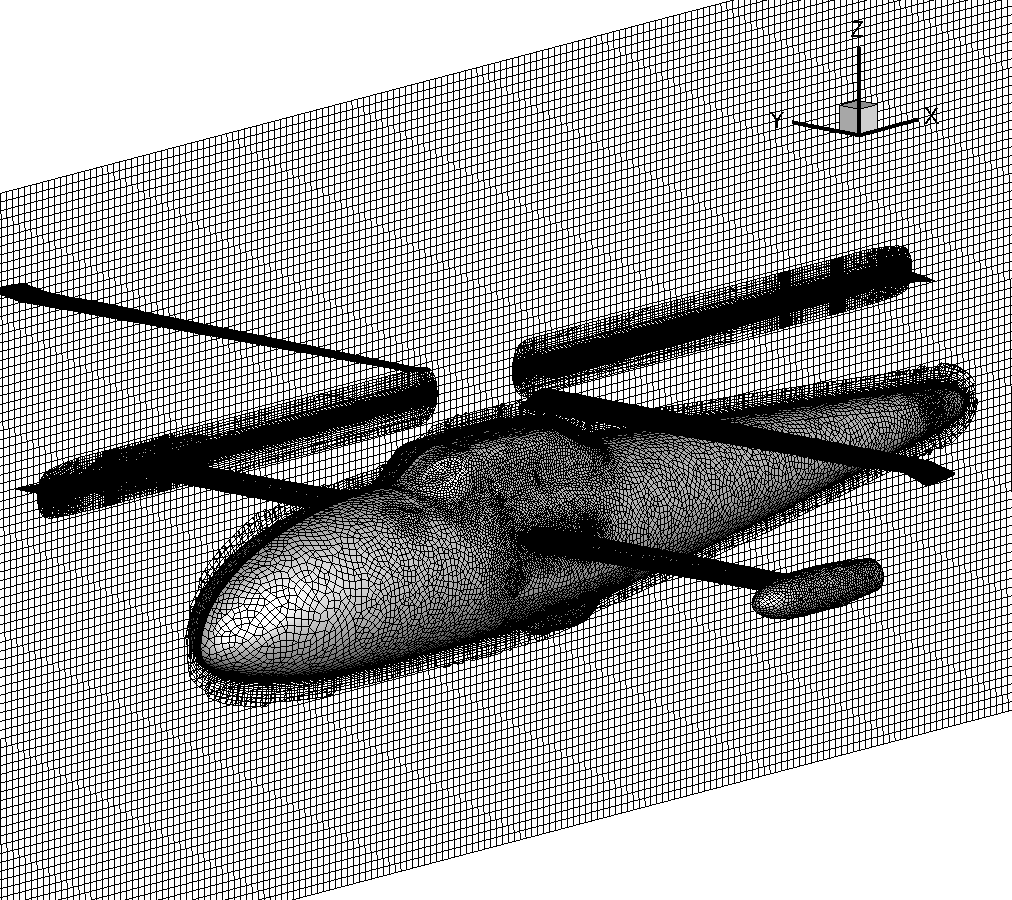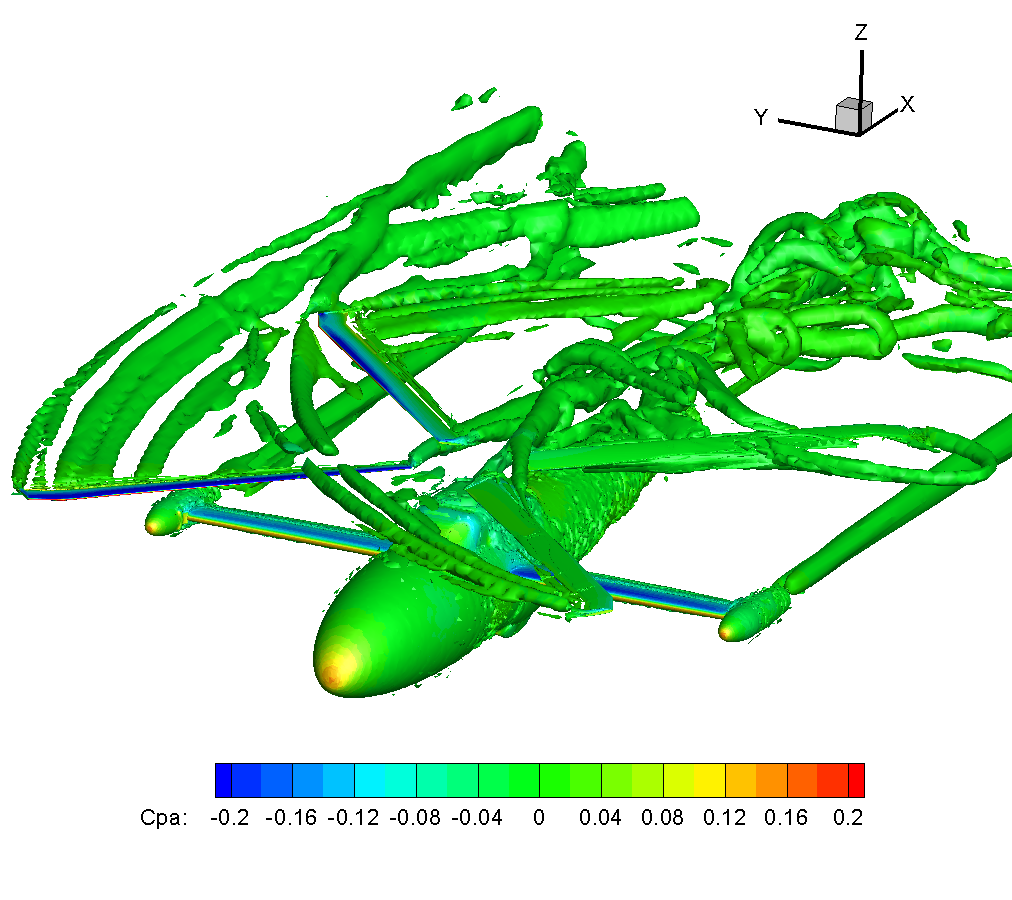JAXA-SUBARU Cooperative Research
JAXA Supercomputer System Annual Report April 2020-March 2021
Report Number: R20ECMP10
Subject Category: Competitive Funding
- Responsible Representative: Yoshikazu Makino, Aeronautical Technology Directorate, Aviation Systems Research Unit
- Contact Information: Yasutada Tanabe(tan@chofu.jaxa.jp)
- Members: Yasutada Tanabe, Hideaki Sugawara, Masahiko Sugiura, Kuniyuki Takekawa, Masafumi Sasaki, Keita Kimura
Abstract
A compound helicopter is one of the high-speed rotorcraft concepts. Aerodynamic interactions occur on the winged compound helicopter, constructed by a single main rotor, winged-body, and multiple propellers. The drag of the rotorcraft drastically increases due to the aerodynamic interaction resulting in significantly reduction of the aerodynamic performance. SUBARU and JAXA have accumulated knowledge about the aerodynamic interaction of compound helicopters through cooperative research so far. This study aims to demonstrate the aerodynamic performance improvement for the compound helicopter utilizing the single rotor lift-offset technology combined with the optimal blade designed by JAXA through numerical simulations.
Reference URL
N/A
Reasons and benefits of using JAXA Supercomputer System
Reason: There are many simulation cases, and the system is needed to get results efficiently.
Advantage: Large-scale simulation that requires much memory can be performed, and the results can be obtained efficiently.
Achievements of the Year
The simulations are performed to evaluate the aerodynamic performance for the simplified compound helicopter model constructed by a single main rotor and a winged-body using the rotorcraft CFD tool, rFlow3D, developed at JAXA. Moving overlapped grids are utilized to simulate the motion of the main rotor blades. Figure 1 shows the computational grid used in the simulation. The overlapping grid comprises the blade grid, the winged-body grid, and the inner/outer background grids. The winged-body grid is an unstructured grid and computed by the unstructured CFD solver, FaSTAR, also developed at JAXA.
The isolated configurations for the rotor and the winged-body are simulated to assess the aerodynamic performance. Subsequently, the rotor and winged-body combination is computed, and the overall performance is evaluated. High-speed flight conditions where the rotor advance ratios are 0.7 and 0.8 are simulated. Figure 2 shows a sample result of the rotor and winged-body configuration.
The overall performance of the compound helicopter is remarkably enhanced by applying the optimized rotor blade for high-speed flight. Furthermore, it is clarified that the lift-offset technology further improves the overall performance.
Publications
N/A
Usage of JSS
Computational Information
- Process Parallelization Methods: N/A
- Thread Parallelization Methods: OpenMP
- Number of Processes: 1
- Elapsed Time per Case: 140 Hour(s)
Resources Used(JSS2)
Fraction of Usage in Total Resources*1(%): 0.27
Details
Please refer to System Configuration of JSS2 for the system configuration and major specifications of JSS2.
| System Name | Amount of Core Time(core x hours) | Fraction of Usage*2(%) |
|---|---|---|
| SORA-MA | 15.28 | 0.00 |
| SORA-PP | 195,782.28 | 1.53 |
| SORA-LM | 0.00 | 0.00 |
| SORA-TPP | 103,893.45 | 9.80 |
| File System Name | Storage Assigned(GiB) | Fraction of Usage*2(%) |
|---|---|---|
| /home | 4,557.01 | 4.18 |
| /data | 26,417.69 | 0.51 |
| /ltmp | 4,861.84 | 0.41 |
| Archiver Name | Storage Used(TiB) | Fraction of Usage*2(%) |
|---|---|---|
| J-SPACE | 6.24 | 0.21 |
*1: Fraction of Usage in Total Resources: Weighted average of three resource types (Computing, File System, and Archiver).
*2: Fraction of Usage:Percentage of usage relative to each resource used in one year.
Resources Used(JSS3)
Fraction of Usage in Total Resources*1(%): 0.97
Details
Please refer to System Configuration of JSS3 for the system configuration and major specifications of JSS3.
| System Name | Amount of Core Time(core x hours) | Fraction of Usage*2(%) |
|---|---|---|
| TOKI-SORA | 5.80 | 0.00 |
| TOKI-RURI | 1,429,558.38 | 8.18 |
| TOKI-TRURI | 163,242.65 | 13.16 |
| File System Name | Storage Assigned(GiB) | Fraction of Usage*2(%) |
|---|---|---|
| /home | 5,079.05 | 3.48 |
| /data | 41,478.32 | 0.70 |
| /ssd | 5,964.99 | 3.11 |
| Archiver Name | Storage Used(TiB) | Fraction of Usage*2(%) |
|---|---|---|
| J-SPACE | 6.24 | 0.21 |
*1: Fraction of Usage in Total Resources: Weighted average of three resource types (Computing, File System, and Archiver).
*2: Fraction of Usage:Percentage of usage relative to each resource used in one year.
JAXA Supercomputer System Annual Report April 2020-March 2021




